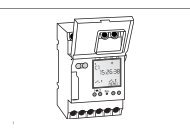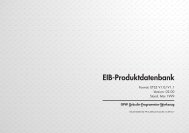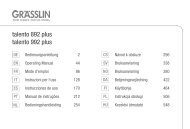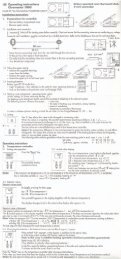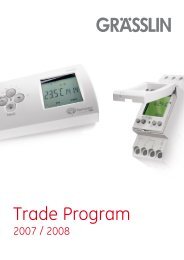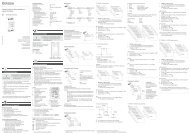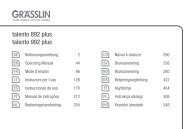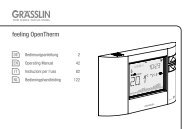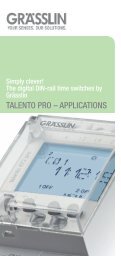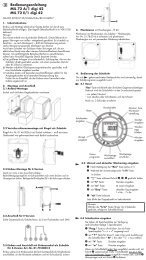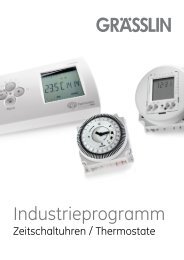Ba talento taxxi (GB)
Ba talento taxxi (GB)
Ba talento taxxi (GB)
Create successful ePaper yourself
Turn your PDF publications into a flip-book with our unique Google optimized e-Paper software.
1. General<br />
You can use the hand programming unit to transmit and receive switching programs (data).<br />
You compile the switching programs:<br />
• on a PC (laptop) with the software „user software"<br />
(see separate manual)<br />
• in the normal way, at the time switch<br />
see the operating instructions for the time switches)<br />
You can transfer the relevant switching program exclusively to the time switch (type)<br />
for which the switching program was complied (pay attention to the application name).<br />
The hand programming unit has 4 program locations.<br />
You can transfer 4 different switching programs of read out switching programs.<br />
Memory locations empty = P 1, P 2, P 3, P 4<br />
Write memory locations = P _ 1, P _ 2, P _ 3, P _ 4<br />
Delete the EEPROM – see the „user software" manual<br />
<strong>GB</strong><br />
2
3<br />
2. Data transfer principle<br />
2.1 From the PC to the hand programming<br />
unit and vice versa<br />
The switching programs are<br />
transferred to the hand programming<br />
unit from the PC<br />
via the serial interface or are<br />
written to the PC by the hand<br />
programming unit.<br />
2.2 From the hand programming unit to the time switch and vice versa<br />
The switching programs are transferred to the<br />
relevant time switch from the hand<br />
programming unit via the infrared interface<br />
or are read out from the time switch<br />
by the hand programming unit.<br />
The switching programs are<br />
also transferred from time switch<br />
to time switch in the same way.<br />
hand<br />
programming<br />
unit<br />
IR interface<br />
hand programming<br />
unit<br />
PC interface<br />
Time switch<br />
<strong>GB</strong>
3. Transferring switching programs<br />
3.1 Unit functions<br />
Key in = receive data<br />
3.2 Transferring switching programs to the time switch and vice versa<br />
<strong>GB</strong><br />
IR interface<br />
Display<br />
Key out<br />
= send data<br />
Key Prog. = select memory locations<br />
With the Prog. key, select the corresponding memory location P_1 .... P_4<br />
• Transfer the contents or<br />
• With a memory location<br />
PC interface<br />
4
5<br />
Hold the <strong>taxxi</strong> directly<br />
on the two IR diodes<br />
(hold the hand programming<br />
unit still during this operation)<br />
Press the corresponding key twice, depending on the transfer direction –<br />
in or out<br />
• Press the key once. The transfer is prepared and the relevant program<br />
location and the assignment<br />
in or out flash alternately<br />
• Press the key again. The data is transferred. An audible signal (continuous<br />
tone) is output during the transfer.<br />
If the data has been correctly transferred, the number of the program location,<br />
e.g. P_ 1, can be seen in the display (of the hand programming unit).<br />
If the data has not been correctly transferred, there is a short, audible signal and<br />
the corresponding error message appears in the display (see Section 5).<br />
<strong>GB</strong>
4. Transferring the time<br />
4.1 From the PC to the hand programming unit<br />
The time is transferred to the hand programming unit from the PC via the serial<br />
interface (see "user software" manual).<br />
4.2 From the hand programming unit to the time switch<br />
The time is transferred via the infrared interface from the hand programming unit to the<br />
relevant time switch or is read out by the hand programming unit from the time switch.<br />
Select “c lo“ with the Prog. key.<br />
Hold the hand programming unit directly on the<br />
two IR diodes (hold the hand programming unit<br />
still during this operation)<br />
Press the corresponding key twice, depending on the transfer direction – in or out<br />
• Press the key once. The transfer is prepared.<br />
c lo and the assignment in or out flash alternately.<br />
• Press the key again. The time is transferred. An audible signal<br />
(continuous tone) is output during transfer.<br />
If the time has been correctly transferred, c lo can be seen in the display. If the time has not been correctly transferred,<br />
there is a short audible signal and the corresponding error message appears in the display (see Section 5).<br />
<strong>GB</strong><br />
6
7<br />
5. Error message<br />
When working with the hand programming unit, it can happen that en error<br />
message appears in the display.<br />
• Er 3 = Time switch not recognised (name of the application is not correct)<br />
• Er 2 = Data not correctly transferred. Repeat the transfer.<br />
• Er 1 = <strong>Ba</strong>tteries not supplying sufficient voltage<br />
6. Changing the batteries<br />
• Undo the screws<br />
• Replace the batteries<br />
• 2 x type LR 6 alkaline (1.5 volt)<br />
• Close the hand programming unit<br />
again<br />
<strong>GB</strong>
7. Technical data<br />
• Power supply 2 x 1.5 volt<br />
(protected against<br />
polarity reversal)<br />
• <strong>Ba</strong>ttery type LR 6 alkaline<br />
• Running reserve min. one year (approx. 1000 transfer operations)<br />
• Protection class III<br />
• Protection type IP 20<br />
• Ambient temperature – 10 °C ... + 55 °C<br />
• Interface to the PC RS 232, 9-pole, SUB - D socket<br />
• Interface to the time switch IR<br />
<strong>GB</strong><br />
8



